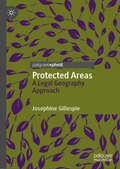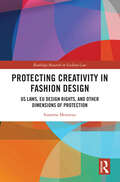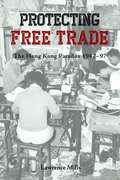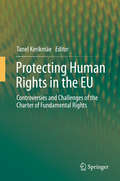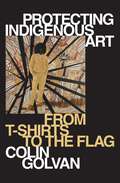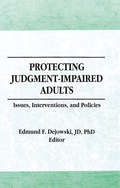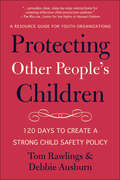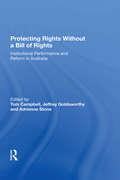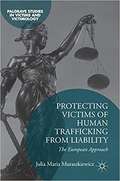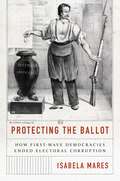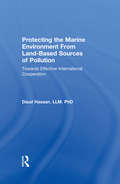- Table View
- List View
Protagonists of Medicine
by Domenico RibattiThe study of medical history is interesting in itself and may help to modify the view sometimes expressed that medical students and doctors are lacking in culture of any sort. Moreover, some historical perspective is often advantageous when one is considering the multitude of advances that are now taking place in the theory and practice of medicine. This book, containing a series of collected papers concerning immunology and pathology and vascular biology and angiogenesis, drives us through scientific milestones in the history of medicine in the course of the past two centuries and highlights the contribution of pioneering scientists whose discoveries have paved the way to many researchers working in the fields of cell biology, developmental biology, immunology, pathology, and oncology. This book will serve as a resource for scientists, historians of medicine and philosophers of science and medicine.
Protected Areas: A Legal Geography Approach
by Josephine GillespieThis book argues that legal geography provides new insights into contemporary conservation challenges. Despite unprecedented efforts, we are facing an extinction crisis, and in situ protected area programs are falling short. This book discusses the protected area phenomenon and calls for changes to current approaches, informed by legal geography –an inter-disciplinary area focused on the intertwined people–place–law dynamics that enable, or disable, effective management practices. The book examines two protected area types: World Heritage Sites, where places of ‘outstanding universal value’ are protected for all humanity, and Ramsar protected wetland sites, one of the first global environmental protection initiatives. Using case studies from the Australasian region (Australia, the Pacific and Southeast Asia), it reveals how current approaches can be improved by taking into account the people–place–law nexus embedded in legal geography research.
Protecting Artificial Intelligence-generated Works in Indonesia: Insights from the European Union Approach (Information Technology and Law Series #41)
by Laurensia AndriniThis book examines the legal challenges posed by generative artificial intelligence (AI) in copyright law, focusing on Indonesia while using the European Union (EU) as a benchmark. It explores whether AI-generated works should qualify for copyright protection, how rights over these works should be allocated, and which stakeholders should be recognised in the process. By addressing these critical issues, the book provides a framework for balancing legal protection with public interests, offering insights for policymakers, legal scholars, and intellectual property practitioners. Adopting a comparative and socio-legal approach, this book analyses Indonesia’s evolving copyright landscape alongside the EU’s response to AI-generated works. While Indonesia prioritizes AI development, its copyright law remains rooted in human authorship, creating legal uncertainties for AI-generated works, despite the significant human contributions involved. This book offers a novel perspective on how middle-income countries can adapt their copyright systems in response to technological advancements. To address the gap in existing copyright law, potential protection models, including sui generis rights and neighbouring rights, are examined. These alternatives advocate for a balanced approach that fosters innovation while safeguarding human contributors. Through the comparative analysis and policy-driven recommendations, the book is an essential resource for academics, legal professionals, and policymakers seeking to navigate the evolving intersection of AI and copyright law. Laurensia Andrini is a Lecturer at the Business Law Department, Faculty of Law of the Universitas Gadjah Mada in Yogyakarta, Indonesia.
Protecting Built Heritage in Hong Kong (SpringerBriefs in Law)
by Steven Brian GallagherThis Brief is the first comprehensive coverage of law and policy intended to protect built heritage in Hong Kong. Although characterized as a city of skyscrapers and modernity, Hong Kong has a rich cultural heritage and a surprisingly rich built heritage. The text considers what “built heritage” means in Hong Kong and what built heritage there is in Hong Kong. It introduces general readers, practitioners and students to the issues facing built heritage protection and how such protection usually develops in a modern city. In particular, it considers the problems and disputes that provided the focus for development of law and policy in Hong Kong, especially the legacy of 150 years as a British colony and the consequent identification as a “borrowed” and “temporary” place. The Brief considers how effective law and policy has been in protecting built heritage under the colonial and post-colonial administrations- their successes and failures. These include the Kowloon-Canton Railway Station, the Antiquities and Monuments Ordinance, reclamation of Victoria Harbour, violent protests at Queen’s Pier, and the introduction of mandatory heritage impact assessments for government projects. The text concludes noting recent successes, which may indicate a brighter future for the protection of Hong Kong’s built heritage.
Protecting Creativity in Fashion Design: US Laws, EU Design Rights, and Other Dimensions of Protection (Routledge Research in Fashion Law)
by Susanna MonseauExploring the debate over the benefits of legal protection for fashion design, this book focuses on how a combination of minimal legal protections for design, evolving social norms, digital technology, and market forces can promote innovation and creativity in a business known for its fast-paced remixing and borrowing. Focusing on the advantages and disadvantages of the main US and EU IP laws that protect fashion design in the world’s biggest fashion markets, it describes how recent US case law in copyright and trademark cases has led to misaligned incentives for the industry and a lack of clear protection, while, in the EU, the CJEU’s interpretation of the pan-European design rights system has created significant overlap with copyright law and risks, leading to the overprotection of design. The book proposes that creativity and innovation in fashion derive some benefit from a limited unregistered design right protection, and that cumulation with copyright protection is unhelpful. It also proposes that there is a larger role for developing social norms relating to sustainability, the ethics of cultural appropriation, and the online shaming of counterfeiters that can also help create a fair equilibrium between protection and borrowing in fashion design.
Protecting Free Trade
by Lawrence MillsProtecting Free Trade is the story of a paradox that both limited and stimulated Hong Kong's post-war economy. In order to preserve its access to open markets, Hong Kong was obligated by international agreements to accept restraints on its exports; and in order to sustain growth, Hong Kong had to subject its largest industry — textiles — to a massive network of restrictions. Protecting Free Trade examines how Hong Kong handled, by negotiation, attempts by developed economies to limit international trade through protective measures. The central argument is that, far from stifling Hong Kong's industry, restrictive international trade agreements became a stimulus for economic success by creating a sellers' market in which Hong Kong was the dominant supplier. The book is also a personal memoir by someone who was deeply involved in policy formulation. Lawrence Mills was deeply involved in many of the critical economic issues that Hong Kong faced in the 50 years leading up to its return to China in 1997. In Protecting Free Trade he tells the inside story of how Hong Kong held on to its vulnerable and volatile role as a global centre of trade, despite the constant pressures to limit its exports, and its sometimes fractious relationships with the UK, the USA, and Europe. He illustrates the political savvy with which negotiators distanced Hong Kong from the UK to gain the support of developing countries as a countervailing force in international trade, but not to an extent that might upset China. He explains why, for the strategic defence of its interests, Hong Kong depended on international trade arrangements and bilateral restraint agreements. Protecting Free Trade also examines the role of the Trade and Industry Departments, which Mills headed, and of their principal advisory boards. It details the bureaucratic systems, including controversial quota controls, that were necessary to give Hong Kong's businessmen stability and room for manoeuvre in fast-evolving markets. Mills also assesses the charge that the department was too close to the constituency that it served.
Protecting Human Rights in the EU: Controversies and Challenges of the Charter of Fundamental Rights
by Tanel KerikmäeHuman rights are much talked about and much written about, in academic legal literature as well as in political and other social sciences and the general political debate. This book argues that the universality of basic human rights is one of the values of the concept of rights. It points out the risk of a certain "inflation" caused by the current habit of talking so much and so often about human rights and of using them as a basis for claims of various kinds. These rights, their understanding and interpretation may need to become more "purist" to ensure that universal human rights as a concept survive. Another chapter concentrates on the analysis of the frames of "EU protected human rights" from the perspective of effective implementation. Further, the book not only deals with the complicated relations between the EU and international law, but also seeks to show the horizontal effect. To that end, the fears and hopes of the member states and interest groups are categorized and commented on. Lastly, the gaps in theory and practice are addressed, current trends related to implementation are pointed out, and suggestions are made concerning how to make the best out of the Charter.
Protecting Indigenous Art: From T-shirts to the Flag
by Colin GolvanThere is the country non-Indigenous people can see, and then there is the country Indigenous people see that the rest of us can barely comprehend, but glimpse through the vivid colours, shapes and imagery of their artworks, and their visual recounting of ancient stories and settings. The unauthorised use of Indigenous artworks is a global industry that damages cultural integrity and harms the livelihoods of artists and their communities. While the western idea of private or individual ownership can be at significant odds with tenets of Indigenous ownership and control, copyright remains one of the primary tools available to protect Indigenous visual artists from fakes, cultural threat and appropriation. In Protecting Indigenous Art, leading intellectual property barrister Colin Golvan provides a privileged insight into how legal protection of Indigenous art offers unique opportunities to empower Indigenous artists and their communities. Golvan gives a first-hand account of landmark legal campaigns such as the unauthorised reproduction of prominent Bulun Bulun artworks on T-shirts, the seminal carpets case, the campaign to recover the copyright of Arrernte artist Albert Namatjira and the extraordinary story of the Aboriginal flag. Altogether, we get an understanding of the importance of protection for this much-loved form of artistic and cultural expression.
Protecting Intellectual Property in the Arabian Peninsula: The GCC states, Jordan and Yemen (Routledge Research in Intellectual Property)
by David Price Alhanoof AlDebasiThis work examines the endeavours of the Arabian Peninsula States – namely the Gulf Cooperation Council member States of Bahrain, Kuwait, Oman, Qatar Saudi Arabia and the UAE, as well as Jordan and Yemen as prospective GCC members – in establishing national intellectual property protection regimes which both meet their international treaty obligations and are also congruent with their domestic policy objectives. It uses the WTO’s TRIPS Agreement of 1995 as the universal benchmark against which the region’s laws are assessed. The challenges faced by the States in enforcing their intellectual property laws receive particular attention. Protecting Intellectual Property in the Arabian Peninsula considers the changing nature of the States’ intellectual property laws since 1995. It argues that the decade immediately following the TRIPS Agreement was marked by a period of foreign forces shaping or influencing the character of the States’ intellectual property legislative regimes, primarily through multilateral or bilateral trade-based agreements. The second and current decade, however, see a significant shift away from foreign influences and a move towards domestic and regional imperatives and initiatives taking over. The work also examines regional initiatives for the protection of traditional knowledge and cultural heritage, as areas of intellectual property which fall outside the parameters of the TRIPS Agreement, but which are of significant concern to the States and other developing countries, and to which they are giving increasing attention in terms of providing proper protection.
Protecting Judgment-Impaired Adults: Issues, Interventions, and Policies
by Edmund F DejowskiThis thorough book provides valuable information on guardianship and alternative methods for serving judgment-impaired adults. To date, much of contemporary guardianship policy has been developed by “muddling through.” This book explores developments in case law concerning the scope of the guardian's authority, the proposed national guardianship act, and proposed changes in federal legislation regarding representative payees, and provides guidance in these important areas of concern.
Protecting National Security: A History of British Communications Investigation Regulation
by Phil GloverThis book contends that modern concerns surrounding the UK State’s investigation of communications (and, more recently, data), whether at rest or in transit, are in fact nothing new. It evidences how, whether using common law, the Royal Prerogative, or statutes to provide a lawful basis for a state practice traceable to at least 1324, the underlying policy rationale has always been that first publicly articulated in Cromwell’s initial Postage Act 1657, namely the protection of British ‘national security’, broadly construed. It further illustrates how developments in communications technology led to Executive assumptions of relevant investigatory powers, administered in conditions of relative secrecy. In demonstrating the key role played throughout history by communications service providers, the book also charts how the evolution of the UK Intelligence Community, entry into the ‘UKUSA’ communications intelligence-sharing agreement 1946, and intelligence community advocacy all significantly influenced the era of arguably disingenuous statutory governance of communications investigation between 1984 and 2016. The book illustrates how the 2013 ‘Intelligence Shock’ triggered by publication of Edward Snowden’s unauthorized disclosures impelled a transition from Executive secrecy and statutory disingenuousness to a more consultative, candid Executive and a policy of ‘transparent secrecy’, now reflected in the Investigatory Powers Act 2016. What the book ultimately demonstrates is that this latest comprehensive statute, whilst welcome for its candour, represents only the latest manifestation of the British state’s policy of ensuring protection of national security by granting powers enabling investigative access to communications and data, in transit or at rest, irrespective of location.
Protecting Nationals Abroad and the Reconceptualization of Sovereignty (Studies in the History of Law and Justice #32)
by Ioanna PervouThis book helps to conceptualize the doctrine of forcible protection of nationals abroad and illustrates the key elements of state practice. States&’ interest in protecting their nationals abroad is timeless; nationality and allegiance are constitutive elements of sovereignty and in some cases, take precedence over territoriality. Yet the forcible protection of nationals abroad has long been debated and attracted the attention of international legal theory. Currently, it is particularly in the spotlight due to Russia&’s invocation of the doctrine in the armed conflict against Ukraine. However, protection of nationals abroad is a concept which is expected to fuel international debate in the years to come, primarily because of globalization and the growing trend of more and more people living outside their country of birth. Chapters 1 and 2 delve into the doctrine of protecting nationals abroad. More specifically, Chapter 1 examines how the doctrine was formulated and applied in the pre-Charter era and explores whether there was a customary rule permitting the use of force to protect a state&’s nationals abroad, while Chapter 2 offers an overview of the doctrinal debate which followed the United Nations Charter and the prohibition of the use of force. In turn, Chapters 3 and 4 take a closer look at state practice from 1945 onwards. Chapter 3 outlines the major features of states&’ practices and their justifications for using force for the sake of their nationals. Chapter 4 assesses the Russian discourse on the protection of nationals abroad, specifically with regard to the armed conflict with Georgia, the rhetoric preceding the annexation of Crimea, and the military invasion of Ukraine. Lastly, Chapter 5 explains how the protection of nationals abroad could be made more human-centric and go beyond jus ad bellum. This chapter re-interprets the concept of &“nationals&” and sheds light on the terms &“expatriates,&” &“naturalized foreigners&” and &“diaspora,&” suggesting that there is a gap between diplomatic and forcible protection, one not reflected in international law regulation and which needs to be addressed.
Protecting Other People's Children: 120 Days to a Strong Child Safety Policy
by Debbie Ausburn Tom RawlingsA one-of-a-kind guide for youth-serving organizations to help build out their own child protection policies in just 120 days.Expert guidance, worksheets, and checklists take the guesswork out of confusing industry standards—so you can focus on helping kids learn, grow, and flourish.Written by two legal experts with more than 60 years of experience helping youth-serving organizations (YSOs), Protecting Other People's Children provides a blueprint for organizations to develop their own child safety policies.From private schools to church youth groups to mentoring organizations to summer camps, YSOs provide unparalleled opportunities for children to learn, grow, and flourish. Unfortunately, because they serve a vulnerable population, those groups also face unparalleled risks.With Protecting Other People's Children, organizations will be able to: Recognize and avoid common pitfalls and mistakes Set up a workable timeline for implementationCreate and confirm their own commitments and principlesAccess several supportive worksheets, checklists, and activity guidesLearn how to pick the right people (leaders, team, volunteers, etc.)Understand and adhere important protocols and guidelinesAppropriately respond to serious incidentsProtecting Other People's Children enables YSOs to develop robust, sustainable child protection plans, holding everyone accountable while protecting both the programs and the minors they serve.
Protecting Privacy in China
by Hao WangToday, privacy is one of the most hotly debated topics worldwide. The book aims to balance the development of personal rights in a country that has historically valued collective rights over those of the individual. The protection of privacy is not an issue that has been emphasised during the rapid development of economic laws in China. However, the accompanying development of greater government-based regulation of these laws' implementation has led to greater invasions of personal privacy. This study attempts to provide a way forward for China to address the ever-increasing concerns about the protection of privacy and puts forward a legislative model for protection. This is achieved after a thorough analysis of the threats to privacy protection in China, a critical evaluation of the level of current privacy protection in China, and an analysis of the privacy laws in a series of developed nations based on common law and civil law.
Protecting Rights Without a Bill of Rights: Institutional Performance and Reform in Australia (Law, Justice And Power Ser.)
by Jeffrey GoldsworthyAustralia is now the only major Anglophone country that has not adopted a Bill of Rights. Since 1982 Canada, New Zealand and the UK have all adopted either constitutional or statutory bills of rights. Australia, however, continues to rely on common law, statutes dealing with specific issues such as racial and sexual discrimination, a generally tolerant society and a vibrant democracy. This book focuses on the protection of human rights in Australia and includes international perspectives for the purpose of comparison and it provides an examination of how well Australian institutions, governments, legislatures, courts and tribunals have performed in protecting human rights in the absence of a Bill of Rights.
Protecting Societal Interests in Corporate Takeovers: A Comparative Analysis of the Regulatory Framework in the U.K., Germany and China
by Huizi AiThe book explores “what are the societal interests that may be affected by a takeover, are these protected under the current regulatory frameworks of the U.K., Germany, and China, (and if so) how are they protected and what recommendations can be made for future reforms in the three jurisdictions?” The book adopts three main methods: law and economics analysis, doctrinal legal research, and comparative analysis.The content of this book is intended not only for the academia; it may also benefit the policy makers by providing an evaluation on the strengths and weaknesses of different protection mechanisms and recommendations for future reforms. Besides, companies which are (potentially) interested in conducting takeovers in the three countries may also find this book useful with its overall analysis of the regulatory frameworks and representative takeover cases in the jurisdictions.
Protecting Traditional Knowledge: The WIPO Intergovernmental Committee on Intellectual Property and Genetic Resources, Traditional Knowledge and Folklore (Routledge Research in International Environmental Law)
by Pedro Roffe Ahmed Abdel-Latif Daniel F. RobinsonThis is the first comprehensive review of the Intergovernmental Committee (IGC) of the World Intellectual Property Organization (WIPO) established in 2000. It provides an in-depth consideration of the key thematic areas within WIPO discussions – genetic resources (GRs), traditional knowledge (TK) and traditional cultural expressions (TCEs) through the perspectives of a broad range of experts and stakeholders, including indigenous peoples and local communities. It also looks at how these areas have been treated in a number of forums and settings (including national systems and experiences, and also in trade agreements) and the interface with WIPO discussions. Furthermore, the book analyses the process and the negotiation dynamics since the IGC received a mandate from WIPO members, in 2009, to undertake formal text-based negotiations towards legal instruments for the protection of GR, TK and TCEs. While there has been some progress in these negotiations, important disagreements persist. If these are to be resolved, the adoption of these legal instruments would be a significant development towards resolving key gaps in the modern intellectual property system. In this regard, the book considers the future of the IGC and suggests options which could contribute towards achieving a consensual outcome.
Protecting Victims of Human Trafficking From Liability: The European Approach (Palgrave Studies in Victims and Victimology)
by Julia Maria MuraszkiewiczThis books demonstrates the difficulty of protecting victims of human trafficking from being held liable for crimes they were compelled to commit in the course, or as a consequence, of being trafficked, under current European law. The legislation remains vague and potentially inadequate to recognise victimhood, safeguard the human rights of victims, and avoid further victimisation. Wiliamson explains how the non-liability principle is rooted in criminal and human rights law, and proposes a more efficient provision and framework which would protect trafficked persons, and do better to encourage victims to act as witnesses in criminal proceedings against the perpetrators. In doing so the book will provide relevant stakeholders, including policy makers and law enforcement authorities, with a better understanding of the non-liability principle and how it ought to be used in practice.
Protecting Your Assets from Probate and Long-Term Care: Don't Let the System Bankrupt You and Your Loved Ones
by Evan H. FarrHave you ever considered the advantages of creating a living trust? Avoiding probate through the use of living trusts is a well-known solution, but author Evan H. Farr takes this issue one step further. In Protecting Your Assets from Probate and Long-Term Care, Farr explains the need to consider both probate and the expenses of long-term care when you create a living trust.A revocable living trust, the main tool used for protecting your assets from probate, does not protect assets from the catastrophic expenses of long-term care. A very useful and popular estate planning tool, revocable living trusts are recommended by tens of thousands of attorneys across the United States and are used as the central estate planning document by millions of Americans. However, what most Americans don’t realize is that assets in such a trust are not protected from lawsuits or from the limitless expenses associated with nursing homes or long-term care.In order to help readers protect themselves from both probate and long-term care, Farr delves into the many details you should know when creating a living trust. He also outlines his Living Trust Plus™ Asset Protection Trust, which is the only type of self-created asset protection trust that allows you to avoid probate and retain an interest in the trust while also protecting the assets from being counted by state Medicaid agencies. He details the process of avoiding probate and securing assets, including:Joint ownership problemsSpecial needs planningHow to pay for the nursing homeWhy Medicaid planning is ethicalThe ten most common Medicaid mythsFinding the right lawyerProtecting Your Assets from Probate and Long-Term Care will help to ensure your family does not have to reap the consequences (and expenses) of improperly creating a living trust.
Protecting Your Company's Intellectual Property: A Practical Guide to Trademarks, Copyrights, Patents and Trade Secrets
by Deborah E. BouchouxIntellectual property continues to soar in value, comprising an increasingly greater portion of a typical company's assets. In the age of instant global communication, understanding what intellectual property is, how to protect it, and how to enhance its value are prerequisites for corporate survival. Packed with fascinating and illuminating examples, this book is a succinct, yet comprehensive discussion of the four key areas of intellectual property: trademarks, copyrights, patents, trade secrets. In addition to defining these areas, Protecting Your Company's Intellectual Property offers practical tools for protecting intellectual property, including: Trademark and copyright application forms, sample employment agreements, an Internet usage policy, tips on preventing unauthorized dissemination of information via the Web, a guide for conducting an IP audit, and much more.
Protecting Your Intellectual Property Rights
by Alan Zimmerman Peggy E ChaudhryCounterfeit products represent a growing problem for a wide range of industries. There are many estimates of the size of this problem most of which coalesce around $500-billion annually on a global basis. Overall, a wide range of industries agree that there is a severe problem with the global protection of intellectual property rights (IPR), yet, there have been virtually no attempts to describe all aspects of the problem. This book aims at giving the most complete description of various characteristics of the intellectual property rights (IPR) environment in a global context. The authors believe a holistic understanding of the problem must include consumer complicity to purchase counterfeit, actions of the counterfeiters (pirates) as well as actions (or inaction) by home and host governments, and the role of international organizations and industry alliances. Only after establishing how all the actors in the IPR environment relate to one another can we describe global protection of the intellectual property rights environment and the managerial response of IPR owners and/or industry associations to combat this ongoing problem. The book concludes with pragmatic recommendations for protecting intellectual property given the recent trends discussed in the previous chapters, making it of interest to practitioners and policy-makers alike.
Protecting the Ballot: How First-Wave Democracies Ended Electoral Corruption
by Isabela MaresHow reforms limiting electoral misconduct completed the process of democratizationBetween 1850 and 1918, many first-wave democracies in Europe adopted electoral reforms that reduced the incidence of electoral malfeasance. Drawing on analysis of parliamentary deliberations and roll-call votes in France, Germany, Belgium, and the United Kingdom, Protecting the Ballot explores how these electoral changes came about.Reforms limiting electoral malfeasance came in a variety of forms. Some reforms imposed harsher punishments for bribing or the politicization of state resources during campaigns. Other changes improved electoral secrecy, providing better protection of voters’ autonomy. By mandating the presence of candidate representatives supervising electoral operations, reforms also reduced the incidence of electoral fraud. Isabela Mares documents how elite splits facilitated the formation of parliamentary majorities in support of electoral reforms. The political composition of these majorities varied across countries and across issue area, depending on the distribution of political resources and the economic and electoral costs incurred by politicians with opportunities to engage in malfeasance. Unpacking the electoral determinants of the demand for reforms, Mares offers an alternative to theories of democratization that emphasize economic considerations alone.By studying the successful adoption of reforms limiting electoral irregularities in first-wave democratic transitions, Protecting the Ballot sheds light on the opportunities and obstacles for ending electoral wrongdoing in recent democracies.
Protecting the Fatherland: Lawsuits and Political Debates in Jülich, Hesse-Cassel and Brittany (Studies in the History of Law and Justice #20)
by Christel Annemieke RomeinThis open access book presents a comparative analysis of the use of fatherland terminology in a political and legal context in Jülich, Hesse-Cassel and Brittany from 1642 to 1655. Fatherland terminology includes words such as patria, patriot and nation. In historiography, the use of these words by the nobility is often interpreted as an early sign of nationalism that conflicted with the prince’s initiation of state-building. The book argues that neither ‘states’ nor ‘nationalism’ truly existed yet; rather, the political arena was dominated by dynasties. Further, it rejects the notion of deliberate state-building and demonstrates that the nobility used this terminology to object to princely politics as part of adopting a “presupposed office.” This status allowed the nobility to place itself outside the ruler-subject constellation and critique the situation. The Duchy of Jülich and the Landgraviate of Hesse-Cassel are used as examples of small economies of scale with homogenous nobilities, and ones where the Thirty Year’s War hit hard – which led to the illegal levying of taxes and the billeting of soldiers, and in turn to the nobility critiquing princely politics. In contrast, the Duchy of Brittany, with its large economy of scale and heterogeneous nobility, found an alternative way of pursuing its interests and keeping taxes as low as possible. The goal of this book is to discuss and present three representative cases that offer insights into how the nobility safeguarded the welfare and prosperity of the fatherland and its inhabitants.
Protecting the Marine Environment From Land-Based Sources of Pollution: Towards Effective International Cooperation
by Daud HassanGlobal findings estimate that 80 per cent of marine pollution originates from land-based sources and is trans-boundary in nature. These problems persist in spite of a number of legal and policy initiatives taken to protect the marine environment. This volume explores the applications and shortcomings of current international regimes in addressing these issues. The book identifies the sources and effects of land-based marine pollution and analyzes the problems of controlling them. Management principles, policy and regulation are examined at both regional and international level. The author discusses the strengths and weaknesses of existing regimes and advances a more effective international legal framework. The text provides a valuable insight into an important area of international environmental law. It will be of interest to researchers and policy-makers working in this area.
Protecting the Mind: Challenges in Law, Neuroprotection, and Neurorights (Ethics of Science and Technology Assessment #49)
by Luca Valera Pablo López-SilvaThis book offers a comprehensive analysis of philosophical, social, ethical, and legal challenges arising as a consequences of current advances in neurosciences and neurotechnology. It starts by offering an overview of fundamental concepts such as mental privacy, personal autonomy, mental integrity, and responsibility, among others. In turn, it discusses the influence of possible misuses or uncontrolled uses of neurotechnology on those concepts, and, more in general, on human rights and equality. Then, it makes some original proposals to deal with the main ethical, legal, and social problems associated to the use of neurotechnology, both in medicine and in everyday life, suggesting possible policies to protect privacy, neural data, and intimacy. Crossing the borders between humanities, natural sciences, bio-medicine, and engineering, and taking into account geographical and cultural differences, this book offers a conceptual debate around policy and decision making concerning some of the key neuroethical challenges of our times. It offers a comprehensive guide to the most important issues of neurojustice and neuroprotection, together with a set of new paradigms to face some of the most urgent neuroethical problems of our times.

